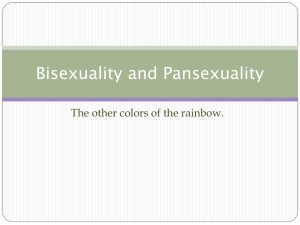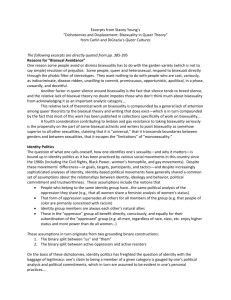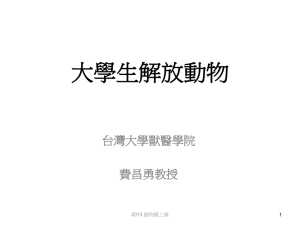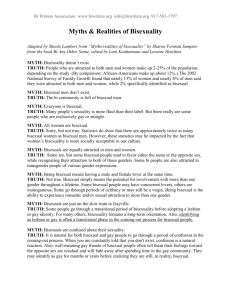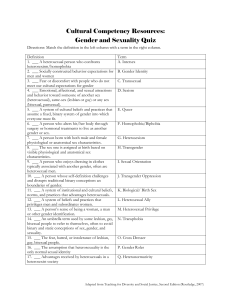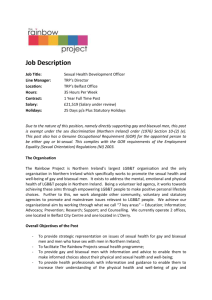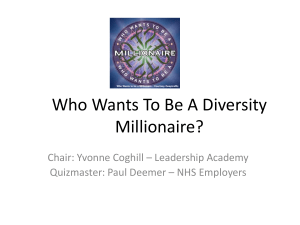Bisexual Media Guide
advertisement
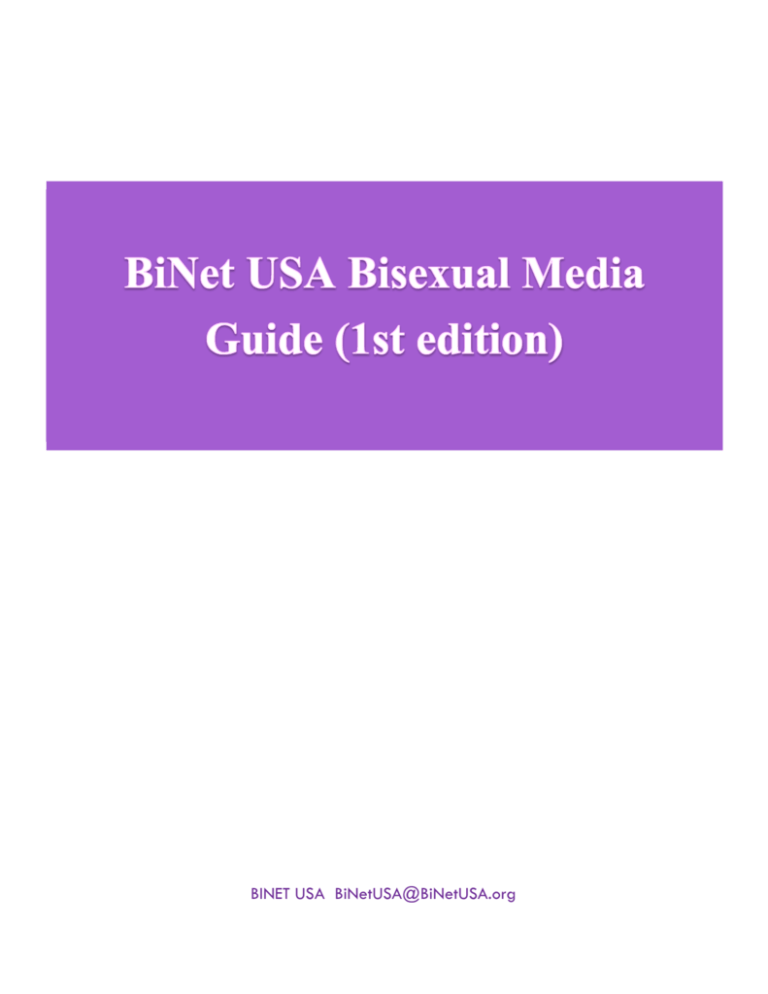
BINET USA BiNetUSA@BiNetUSA.org BiNet USA Bisexual Media Guide Table of Contents BiNet USA Bisexual Media Guide ......................................................................................................... 2 GENERAL TERMINOLOGY ......................................................................................................... 2 BISEXUAL-SPECIFIC TERMINOLOGY ...................................................................................... 2 BISEXUAL TERMS TO AVOID ........................................................................................................ 3 PROBLEMATIC TERMS ............................................................................................................... 3 DEFAMATORY TERMS ................................................................................................................ 3 NAMES, LABEL USAGE & DESCRIPTIONS ............................................................................... 4 Acknowledgments .................................................................................................................................. 6 BiNet USA Bisexual Media Guide GENERAL TERMINOLOGY Bisexual, Bi A person whose enduring physical, romantic and/or emotional attraction is to other people of various sexes and/or gender identities. Individuals may experience this attraction in differing ways and degrees over their lifetime. Never use a hyphen when spelling bisexual. Avoid classifying information about bisexual people, communities and identities as “bisexuality,” instead use “bisexual” to refer to bisexual content. Using “bi” is often more preferable, so when in doubt always ask. Biphobia Prejudice and/or fear of bisexuals. Prejudice against bisexuals often occurs on both a cultural and personal level based on stereotypes, including inaccurate and harmful associations with infidelity, transphobia, binarism, confusion over their sexual orientation, promiscuity and transmission of sexually-transmitted diseases. See bisexual erasure. BISEXUAL-SPECIFIC TERMINOLOGY Bisexual erasure, Bi erasure Bisexual erasure or bisexual invisibility is the tendency to ignore, remove, falsify, or re-explain evidence of bisexuality in history, academia, news media and other primary sources. Bisexual erasure is often influenced by biphobia. Avoid bisexual erasure in headlines. If the story is about a bisexual person, the headline should NOT use “gay”; instead use “bi”. See biphobia. Misorientation Misorientation occurs when bisexual people are identified incorrectly as gay, lesbian or straight using current or previous relationship status instead of personal identification. When one or both members of a featured same-sex couple are bisexual, be sure to correctly identify them as such. Misorienting bi people leads to unnecessary and deeply harmful mental stress. AVOID: Opposite-sex couple, straight couple, heterosexual couple, gay couple and lesbian couple unless appropriate. Mixed-Orientation Marriage A mixed-orientation marriage is a marriage between partners of differing sexual orientations and frequently occurs with bisexual people. Mixed-orientation marriages can have same-sex/gender or different-sex/gender partners but the bisexuals involved remain bisexual. Different-Sex Couple A romantic pairing involving two people of different-sexes/genders. The individuals involved may identify with any sexual orientation. Bisexuals and many other LGBT people may prefer to honor and recognize their relationship status with other ceremonies or ways than marriage. Seek to honor committed relationships no matter the sex or gender. Same-Sex Couple A romantic pairing involving two people of same-sexes/genders. The individuals involved may identify with various sexual orientations including gay, lesbian, and bisexual. BISEXUAL TERMS TO AVOID PROBLEMATIC TERMS Problematic: “bi-sexual”, “BiSexual” Preferred: “bisexual” Do not use a hyphen in bisexual and only capitalize bisexual when it’s used at the beginning of a sentence. Problematic: “Chris Jones, who currently identifies as bisexual”, “Chris Jones, who identifies as bisexual”, “Chris Jones, a self-avowed bisexual”. Preferred: “Chris Jones, a bisexual based in…” or “Chris Jones, a bisexual mom of two”. It’s offensive to describe bisexual people as if their identity is transitory and is not a confirmed part of the person. Problematic: “gay marriage,” “gay and lesbian couples,” Preferred: “marriage equality,” “gay, lesbian, and same-gender couples,” “couples in the LGBT community” Use “gay, lesbian, and same-gender” when discussing gay, lesbian and same-gender couples denied the right to have their marriages honored and acknowledged by state or federal law. See misorientation. DEFAMATORY TERMS Defamatory: "fence-sitter," "breeder," "bi-curious," "lesbian until graduation," “bisexual until graduation,” "college lesbian," "gay for pay," “buy-sexual,” "half-gay," "halfstraight," "Bi-Sexual," "bar-sexual," "switch-hitters,” "try-sexual," “Part-time Gays,” “Goes Both Ways,” “Swings Both Ways,” “Down Low,” The bisexual orientation is an integral, valid and permanent part of a person’s identity. Do not characterize bisexual people as "passing," as “confused,” as “indecisive,” as "lying" to other people, or as "pretending" to be bisexual. Such descriptions are defamatory and insulting and should ONLY be used when discussing and explaining such negative stereotypes. Defamatory: "bisexuality reinforces the gender binary," "bisexuals are gender-binarists" Recent slur frequently used by those uneducated on the history of the bisexual and transgender/gender non-conforming communities, identities, and experiences. In 1990, the Bisexual Manifesto stated: “Bisexuality is a whole, fluid identity. Do not assume that bisexuality is binary or duogamous in nature: that we have ‘two’ sides or that we must be involved simultaneously with both genders to be fulfilled human beings. In fact, don’t assume that there are only two genders.” DO recognize that bisexuals define their identity as being attracted to those of the same-sex/gender or to those of different-sex/genders. Defamatory: "hot sexy bi babe”, "bi babes," “only hot because she’s bi,” “double your chances on a Saturday night,” Avoid any term that equates a bisexual person’s desirability to their bisexuality. Do not imply that being bisexual makes one more desirable as a sex partner. Doing so contributes to the high rates of sexual victimization bisexuals experience. Do not reference the Woody Allen quote about “doubling your chances on a Saturday night”; this is far different from what most bisexuals experience. NAMES, LABEL USAGE & DESCRIPTIONS Numerous polls and surveys indicate the bisexual population to be 40-51% of the entire lesbian, gay, bisexual, and transgender community. Many transgender persons, regardless of gender identity, also identify as bisexual. As a large community, bisexual people predominantly use “bisexual” as a Community Identity Label (similar to “lesbian,” “gay,” “straight,” or “queer”). Use of a Community Identity Label helps describe commonalities, create safe spaces and is essential to tracking the high number of health and safety disparities bisexuals experience. At the same time many bisexuals use Personal Identity Labels which serve a vital function in describing differences while giving each individual a space to be unique. Personal Identity Labels like “pansexual,” “bi-dyke,” or “queer,” may also reflect a particular attitude towards ideas such as Gender Theory. While some people call themselves “pansexual,” “fluid,” “omnisexual,” “flexisexual,” “heteroflexible,” “non-monosexuals,” and/or “queer,” DO NOT use these terms UNLESS someone is self-identifying in this way. It’s important to note that many bisexuals use other terms than bisexual to avoid the immediate stigma that occurs when they self-identity as bisexual in gay, lesbian or straight spaces. The preferred shorthand for bisexual is “bi”. DIRECTORY OF BISEXUAL COMMUNITY RESOURCES American Institute of Bisexuality Denise Penn, Vice President DenisePenn@aol.com www.bisexual.org BiNet USA Faith Cheltenham, President (800) 585-9368 www.binetusa.org BiNetUSA@BiNetUSA.org www.facebook.com/groups/binetusa Bisexual Organizing Project Camille Holthaus, Chair bop@bisexualorganizingproject.org www.bisexualorganizingproject.org Bisexual Resource Center Ellyn Ruthstrom, President (617) 417-3724 president@biresource.net www.biresource.net Boston Bisexual Women’s Network Robyn Ochs (617) 413-2717 robyn@robynochs.com www.biwomenboston.org Acknowledgments A BiNet USA Project with co-sponsorship from: The American Institute of Bisexuality; the Bisexual Resource Center; the Bisexual Organizing Project; the New York Area Bisexual Network (NYABN); Bialogue; DC Alliance of Multicultural Bisexuals (AMBi); Los Angeles Bi Task Force; and Bisexual Books. Bi Media Working Group, chaired by Faith Cheltenham, BiNet USA President: Aud Traher, Sarah Stumpf, Meredith Lively, Cynthia Connors, Estraven, Loraine Hutchins, Stacey Langley, Helen Acosta, Denise Penn, Ellyn Ruthstrom, AJ Walkley, Amy Andre, Lindasusan Ulrich, Gary North, Emily Dievendorf, ABilly Jones-Henin, Martin Rawlings-Fein, Peter M. Ruggiero, Jim Larsen, Lauren Beach, Dr. Mimi Hoang, Morgan Goode, Heron Greenesmith and Ron Suresha. Further Reading: Bi Any Other Name by Loraine Hutchins and Lani Ka‘ahumanu Bisexual Invisibility: Impacts and Recommendations by the San Francisco Human Rights Commission Getting Bi: Voices of Bisexuals Around the World, edited by Robyn Ochs & Sarah Rowley Bi Men: Coming Out, edited by Pete Chvany and Ron Suresha http://www.biresource.net/waybeyondthebinary.shtml http://www.transcendingboundaries.org/resources/mixed-orientationmarriage.html http://fliponymous.wordpress.com/

